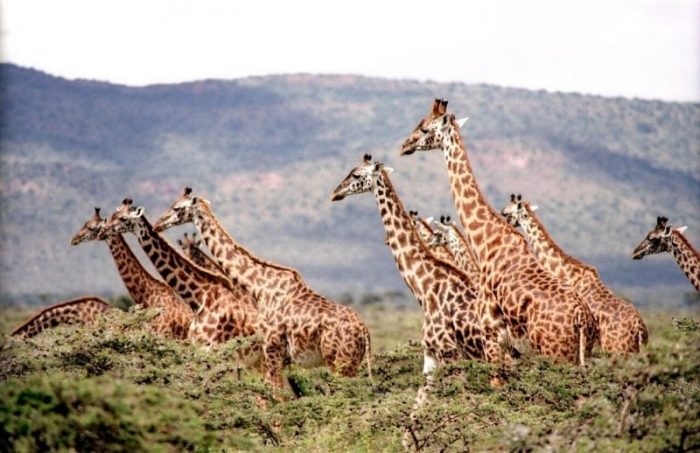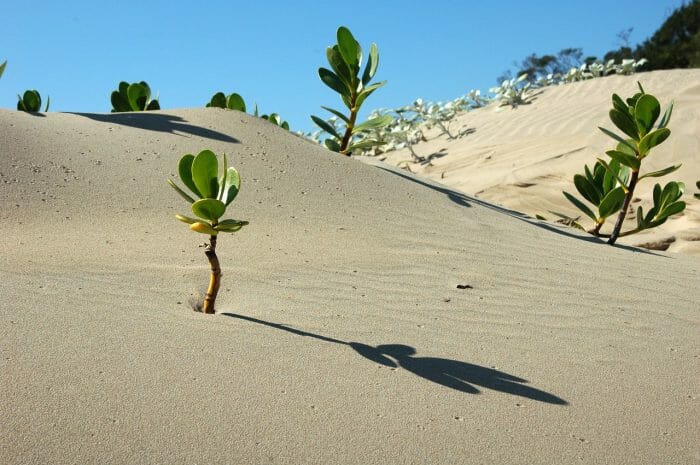
Abiotic and biotic factors are the nonliving and living parts of an ecosystem, respectively. For example, abiotic factors can be the temperature, air, water, soil sunlight, anything physical or chemical. Biotic factors include plants and animals, insects, bacteria, fungi, birds, and anything else living in an ecosystem.
Ecosystems are made out of complex interactions between living creatures and environmental factors. These different factors are referred to as biotic and abiotic factors, respectively. These abiotic and biotic factors encompass a massive range of organisms and environmental pressures, and they all influence one another.
Because there are so many different subgroups of biotic and abiotic factors, it would be helpful to take a closer look at abiotic and biotic factors and cover some specific examples of both factors.
Biotic Factors

Giraffes eating plants are an example of biotic factors influencing other biotic factors. Photo: mrslorettarsmith0 via Pixabay
Biotic factors are any organisms found within an ecosystem, including all animals and microbial life. Organisms impact each other and the environment around them, through predation, habitat construction, and waste. Individual organisms impact the success of other members of their species, the larger community, and the world as a whole.
Types of Biotic Factors:
- Autotrophs
- Heterotrophs
- Detritivores
Autotrophs
Animals and other forms of life are often defined by the kind of food they subsist on and the methods by which they acquire sustenance. Autotrophs are organisms that create their own food by converting the chemical energy that comes from the sun into nutrients, through the process of photosynthesis. Autotrophs use different pigments to absorb different wavelengths of light, of which the most well-known kind is chlorophyll, which gives many plants their green color.
“The plants have enough spirit to transform our limited vision.” — Rosemary Gladstar
Some autotrophs don’t use photosynthesis, and instead, use a process known as chemosynthesis to create food. This process allows autotrophs to utilize the organic material in the surrounding area to create food without sunlight. Examples of these chemosynthetic organisms are the bacteria that live near hydrothermal vents in the ocean, which absorb hydrogen sulfide in the water to create nutrients. Autotrophs create elemental carbon through these two processes, and they function as the base of the entire food chain.
Heterotrophs
Unlike autotrophs, which make their own food, heterotrophs must consume autotrophs to get sustenance. Heterotrophs eat either plants or other animals. Herbivores like sheep and deer eat plants, while the carnivores in the food chain eat the herbivores. Omnivores eat both other animals and plants. Heterotrophs also include things like fungi and bacteria. Heterotrophs don’t fix carbon like plants do, and as a group, they make up about 95% of the diversity of life on Earth.
Detritivores
Detritivores are a different kind of consumer. While they don’t produce their own nutrients, they also don’t eat living organisms. Detritivores subsist on organisms that have died, and they break down the corpses of animals and plants to get energy. Fungi, dung beetles and earthworms are all examples of detritivores. Detritivores are consumed by heterotrophs, giving energy to them, which completes the cycle of nutrients flowing through the food web.
Abiotic Factors

Abiotic factors are things like sunlight and heat, which can influence the success of things like desert plants. Photo: 12019 via Pixabay
Abiotic factors are any physical and chemical factors that influence an ecosystem. Abiotic factors can include humidity levels, amount of sunlight, temperature levels, and soil pH levels. Abiotic factors influence how organisms within an ecosystem are able to reproduce, thrive, and survive. If there isn’t enough sunlight in an ecosystem or not enough water, fewer plants can grow, which means that fewer animals can survive on these plants. Abiotic factors influence not only individual members of a species, but also the species as a whole.
Types of Abiotic Factors:
- Edaphic
- Climatic
Edaphic
Edaphic abiotic factors are those which make up the floor or crust of the Earth. This means edaphic abiotic factors include things like the topography of the land, as well as soil characteristics such as the pH value of the soil. As an example, elevation affects the kinds of organisms that can live on a particular point on the globe, as the density of the air and amount of solar radiation changes with elevation. Aspects like the structure and composition of soil influence which plants can grow in said soil, which influences which animals can live there.
“The nation that destroys its soil destroys itself.” — Franklin D. Roosevelt
Climatic
Climatic factors include atmospheric conditions like humidity and temperature. The amount of water that comes down as snow or rain influences which kinds of animals and plants die or thrive, some animals need a lot of water, while some desert plants do better with relatively little water and die if they are exposed to too much. Even things like wind can influence life in an area, as regions with powerful winds frequently have plants that are stunted and closer to the ground, whose seeds are dispersed by the wind.
Changing Factors And Social Factors
Humans and other animals can have effects on an ecosystem through the changing of an environment. Groups of animals can influence the environment around them through the creation of shelter to survive or tools to use in their habitat. Social aspects of a species can also have impacts on ecosystems. While other animals create structures and use tools, humans are one of the most visible examples of both social abiotic factors and how a species can change aspects of the environment.
“Agriculture is the most healthful, most useful, and most noble employment of man.” — George Washington
The way land is utilized, whether for agriculture or housing, are examples of how social factors can influence land and the environment. The actions taken to secure resources, like mining and forestry can also lead to wider changes in the ecosystem and the environment. Deforestation removes trees, and that can lead to losses in biodiversity and the transformation of that ecosystem.
Abiotic And Biotic Stresses
When an organism is damaged by other organisms, this is referred to as biotic stress. When an organism is damaged by environmental or climate-based factors, it is referred to as abiotic stress. Examples of abiotic stress include harsh rain or snow, drought or flood, heavy winds, and natural disasters like wildfires. Biotic stresses are things like pest infestation, fungal blight, and being eaten in general.
Both abiotic and biotic stresses are evolutionary pressures that influence which genes get will get passed on to the next generation, playing a critical role in evolution.









